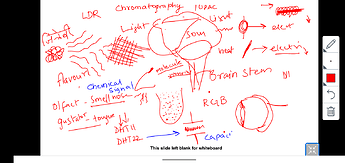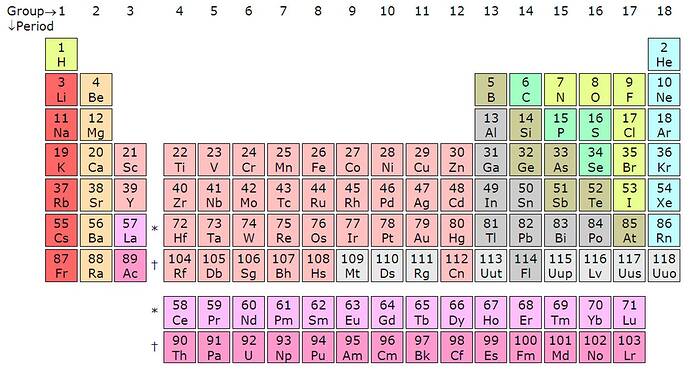Yesterday and today we further discussed about olfactory sensors implementation.
We have covered lot more points to make actual sensor process easier. As you can see on above whiteboard we have covered points like
 Human smell and taste perception
Human smell and taste perception
 Exact meaning of smelling and tasting
Exact meaning of smelling and tasting
 How we smell and taste?
How we smell and taste?
 Background processing
Background processing
 Role of axon
Role of axon
 Working of other electronic sensor
Working of other electronic sensor
 Artificial neural sensor
Artificial neural sensor
 Building database
Building database
 Producing Artificial smell creator
Producing Artificial smell creator
 Nano technology model
Nano technology model
 Wider project imputation
Wider project imputation
▪️ Human smell and taste perception
Meaning of tasting and smelling any chemical constituents of substance is known as perception of flavour.
Flavour contents composition of various parameters like various contents, sensitivity and specificity. For gustatory  sensor the parameters are more enhanced, like pressure, temperature, texture and etc.
sensor the parameters are more enhanced, like pressure, temperature, texture and etc.
▪️ Exact meaning of smelling and tasting
When we smell or taste something we are doing different process all together but here is the connection between olfactory:nose: sensor and gustatory  sensor, it is perception of flavour.
sensor, it is perception of flavour.
For example -
• We have to sniff flavour of food and then odarant (molecule of smell) will pass through nose. But flavour perception is not continuous flow of molecules it has some duration and intensity.
• When we taste any substance flavour on our tongue  we get various factor like Pressure, temperature, texture and five different taste like sour, bitter, sweet, salty, umami (special).
we get various factor like Pressure, temperature, texture and five different taste like sour, bitter, sweet, salty, umami (special).
▪️ How we smell and taste?
• Smell- when we sniff molecule of flavour it is collected in our nose  at the tip of hair like cilia inside the nose and this molecule sensenation further goes to brain. We have billions of olfactory receptor.
at the tip of hair like cilia inside the nose and this molecule sensenation further goes to brain. We have billions of olfactory receptor.
• Taste- when we taste any flavour we have particular section for 5 tastes in our toungue  . In that we have 5k to 10k taste buds. Taste buds are basically the papillae (like this {
. In that we have 5k to 10k taste buds. Taste buds are basically the papillae (like this { } it is small elevated pores for sensation)
} it is small elevated pores for sensation)
▪️ Background processing
For smell when sniff molecule and this sensation from nose is transfer through brain by neuron network. The same network reponsible for reflex action. When this neuron carries sensation in brain  it reach to middle part of forehead (point between eyes
it reach to middle part of forehead (point between eyes  )
)
Where processing of sensation begins this message then pass through chemical receptors of brain by transferring them from solid to liquid medium in upper cortex of the brain  and in special side part of brain transfer this signal through axons to spinal cord to complete reflex action and create perception of smell.
and in special side part of brain transfer this signal through axons to spinal cord to complete reflex action and create perception of smell.
In smell we get lot of depth of the smell.
But is taste we get only 5 tastes but we get different parameters of substance.
Like for olfactory  sensor, we have different aspect of gustatory
sensor, we have different aspect of gustatory  sensor processing it has different brain lobs and parts which create perception of flavour.
sensor processing it has different brain lobs and parts which create perception of flavour.
▪️ Role of axon
Axon are the special sensory neural network which is responsible for all sensation in the human body system.
When we touch, see, hear, smell, taste it is because of this strong neural network. They are billions of this present throughout in human body.
Axon
They have dendrites on the the tip and by they connect with each other form long network. Axon is mainly responsible creating impulse by conducting electric charge through it.
Human can sense fastly to 45 milliseconds and slowly to 180 milliseconds. It depends upon fat present on the side of axon if fats are more impulse will not create conduction rapidly and we will response slowly. Because of this old or ill person lost sensitivity of taste, smell and other sensation. So to conduct electric charge quickly we must have narrow hollow space through which current can flow easily, like water flows from pipe easily when it is not chocked.
▪️ Working of other electronic sensor
To make olfactory  sensor we have to first see the others sensor which are alternatives of other human body system.
sensor we have to first see the others sensor which are alternatives of other human body system.
Like for example for eyes and ears we have sound and camera sensors. In  like eyes the light is pass through our eyes and it reflects on backside of eyes screen that signal of light is then conducted into electrical impulses and this process in brain converts and process light sensitivity and specificity to create perception of vision. Same for
like eyes the light is pass through our eyes and it reflects on backside of eyes screen that signal of light is then conducted into electrical impulses and this process in brain converts and process light sensitivity and specificity to create perception of vision. Same for  when we hear something the vibration of sounds strikes on ear
when we hear something the vibration of sounds strikes on ear  drums and this process then converted into perception of sound.
drums and this process then converted into perception of sound.
▪️ Artificial neural sensor
To create model sensor like camera  we have choose different aspects of chemical composition like we collect light aspects for
we have choose different aspects of chemical composition like we collect light aspects for  . To make that we have to use universal element of periodic table for calibration. Then we have to find different diamagnetic, ferromagnetic, electric conductivity and etc properties of element. Then we have to make systematic approach for properties which can be use for perceiving flavour sensation i.e. smell
. To make that we have to use universal element of periodic table for calibration. Then we have to find different diamagnetic, ferromagnetic, electric conductivity and etc properties of element. Then we have to make systematic approach for properties which can be use for perceiving flavour sensation i.e. smell  .
.
▪️ Building database
So, now we know the parameters and how can use properties of element to generate smell detection prototype. But when we get this it is limited to only one element but their are 118 elements in periodic table. Then we have to carry out further research to search all properties of all elements which we know. We can get all properties behaviour in column and periods in periodic table.
By collecting measurements we will get different patterns for different elements. Now database works starts so,
• We have to combine this element with each other, then we have to group them in order by periodic table and collect all measurements and patterns and we have to cross verify many times to achieve supreme accuracy.
• Now like this further we have to go for like finding NaCl and sugar smell we have to calculate and collect different parameters data points.
• After all this we will get to final data collection points which is real life samples like perception of tea  . We have to find chemical composition and chemical reaction formula for tea.
. We have to find chemical composition and chemical reaction formula for tea.
For example for  we need water, milk, tea powder, sugar.
we need water, milk, tea powder, sugar.
So, formula for tea will be look like this

▪️ Producing Artificial smell creator
So, if we create huge database then we will deeply know the exact pattern or we will get idea about every element, mixture of element, involvement of chemical reaction. By collecting this data aspects we can associate it to create artificial olfaction. By doing this we can produce smell which will help to perceive flavours.
▪️ Nano technology model
By using Nano technology model and small chips and microprocessor we have to convert it into small sensor.
▪️ Wider project imputation
When we create full fledged sensor by following all the steps we can use it in all every aspects which requires  to sense the condition of environment.
to sense the condition of environment.
So, that’s the discussion going on in makers space from 2days. Please join the webinar or contribute through chat to convert dream into realistic sensor which we can use as we think.
![]() THETA- to make daily small compact device as a speaker sensor which can give us fragrance and auroma of all things which we will watching on our tv and phones for example
THETA- to make daily small compact device as a speaker sensor which can give us fragrance and auroma of all things which we will watching on our tv and phones for example![]() BETA- to use this sensor in medical and security for example
BETA- to use this sensor in medical and security for example![]() ALPHA- this is the predator version of this sensor we can use it at commercial level for example
ALPHA- this is the predator version of this sensor we can use it at commercial level for example![]() nose which will detect all the atmosphere like nose though there is not an atmosphere but after further result we can get idea about life in another planet because we breathe through nose
nose which will detect all the atmosphere like nose though there is not an atmosphere but after further result we can get idea about life in another planet because we breathe through nose ![]() and by using as a sensor we not need any mission to go come with sample we can detect and research on that outer space and can find life.
and by using as a sensor we not need any mission to go come with sample we can detect and research on that outer space and can find life.![]() speaker
speaker ![]() on the basis of air.
on the basis of air.![]() is used to carry out smell sensation.
is used to carry out smell sensation.


